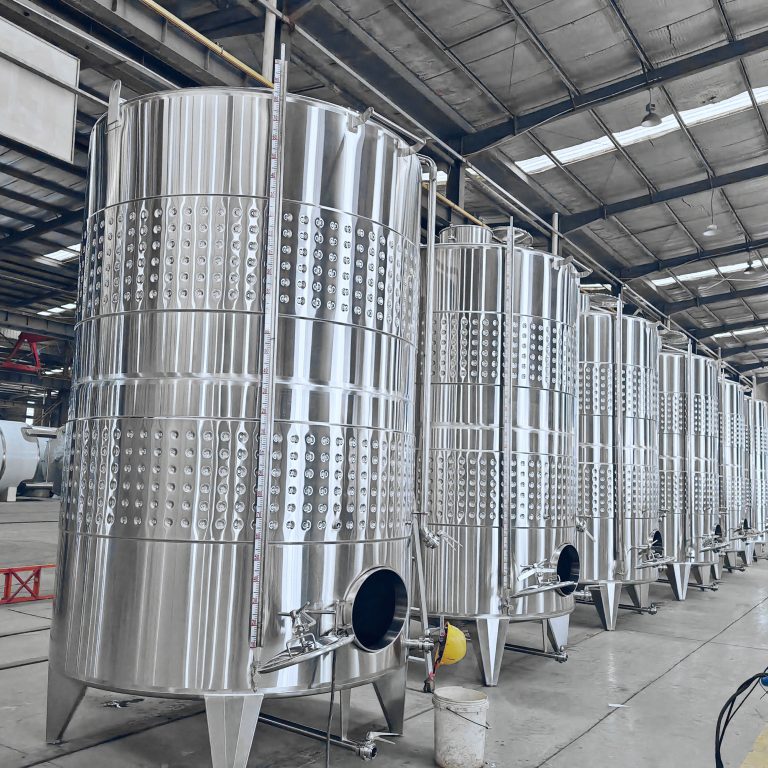Beer and wine fermentation tanks serve similar purposes — both are used to ferment liquids by allowing yeast to convert sugars into alcohol. However, they differ in design, features, and functionality based on the requirements of beer and wine fermentation processes. Let’s break it down:

1.Tank Shape and Design:
Beer Fermentation Tanks (Cylindroconical Fermenters):
Beer Fermentation Tanks:
Beer Fermentation Tanks (Cylindroconical Fermenters):
- Typically cylindroconical in shape with a cone-shaped bottom.
- The cone at the bottom allows for easy collection of yeast and trub (sediment), which can be harvested or discarded.
- Designed for closed fermentation, keeping out oxygen to avoid contamination and spoilage.
- Often equipped with pressure relief valves, allowing controlled release of CO2 during fermentation.
- Wine tanks are usually cylindrical with a sloping flat bottom.
- Can be either open-top or closed, depending on the type of wine being produced.
- Floating lid tanks are common, allowing the lid to adjust to the wine level and minimize oxygen exposure.
- Wine tanks prioritize managing temperature and oxygen exposure, but don’t need the same conical bottom for yeast collection as beer tanks do.
Beer Fermentation Tanks:
- Designed to withstand higher pressures, especially during the active stages of fermentation when CO2 production is significant.
- They often have the ability to ferment under pressure, which helps carbonate the beer naturally.
- Generally, wine tanks are built to handle atmospheric pressure since wine fermentation doesn’t produce as much gas (CO2) as beer fermentation.
- •Open-top tanks may be used for red wines to facilitate punchdowns (mixing the skins into the fermenting juice).

3.Temperature Control:
Beer Fermentation Tanks:
Beer Fermentation Tanks:
Beer Fermentation Tanks:
Beer:
Beer:
- Often equipped with dimple plate cooling jackets or sprical cooling jacket to maintain precise, lower temperatures, which are critical for controlling yeast behavior and producing the desired beer style.
- Ale fermentation typically happens at higher temperatures (15-24°C), while lager fermentation occurs at much lower temperatures (7-13°C).
- Temperature control is also important, especially for white wines, which are often fermented at lower temperatures (around 12-18°C) to retain delicate aromas.
- However, for red wines, fermentation can occur at warmer temperatures (20-30°C), making precise temperature control less critical compared to beer.
Beer Fermentation Tanks:
- The conical shape helps collect yeast and sediment for either reuse (yeast harvesting) or disposal.The yeast can be drained from the bottom without disturbing the beer.
- Since yeast collection is less important, wine fermentation tanks typically don’t have a conical bottom.The sediment (lees) can be racked off (siphoned) after fermentation.
Beer Fermentation Tanks:
- Beer is highly sensitive to oxygen exposure, so closed, airtight tanks are necessary to prevent oxidation, which can spoil the beer.
- While oxygen exposure is also a concern for wine, certain wines (especially red wines) benefit from controlled oxygen exposure to enhance flavor development.
- Open-top fermenters or floating lid tanks with floating lids are more common in wine production, particularly for red wines.
Beer:
- Fermentation typically lasts from 2 to 4 weeks, depending on the beer style and yeast strain.
- Fermentation tanks are often pressurized, especially during secondary fermentation, to carbonate the beer.
- Fermentation can take 1 to 3 weeks but is often followed by longer aging (months or even years), typically in other vessels (barrels or secondary tanks).
- Wine fermentation is generally not pressurized since carbonation isn’t needed (except for sparkling wines).
Beer:
- Beer fermentation tanks often have mechanisms for recirculating wort or dry hopping (adding hops during fermentation), though this is done more in craft brewing.
- Yeast may also need to be harvested and reused, so tanks are designed for efficient yeast handling.
- In red wine fermentation, punching down or pumping over is necessary to mix the skins (pomace) with the wine during fermentation. Tanks may include ports for such processes or devices to automate it.

8.Materials:
Both beer and wine tanks are typically made from stainless steel, which is easy to clean, resists corrosion, and doesn’t react with the fermentation process. However, some wine fermenters may also be made from oak, depending on the winemaker’s preferences for flavor influence.
9.Additional Features:
Beer Tanks:
Both beer and wine tanks are typically made from stainless steel, which is easy to clean, resists corrosion, and doesn’t react with the fermentation process. However, some wine fermenters may also be made from oak, depending on the winemaker’s preferences for flavor influence.
9.Additional Features:
Beer Tanks:
- May include features for dry hopping, yeast harvesting, carbonation stones, and fittings for CO2 and nitrogen gas.
- Some tanks feature floating lids for flexible volume management, as well as large doors for easy removal of grape solids (especially in red wine fermentation).
| Feature | Beer Fermentation Tank | Wine Fermentation Tank |
|---|---|---|
| Shape | Cylindroconical (conical bottom) | Cylindrical, flat or sloped bottom |
| Pressure | Pressurized (for carbonation) | Non-pressurized (except sparkling wine) |
| Temperature | Precise, glycol jackets or sprial cooling coils | Cooling jackets or spiral cooling channel (not always) |
| Yeast Handling | Conical bottom for yeast collection | Yeast often not harvested or reused |
| Fermentation Time | 2–4 weeks (shorter) | 1–3 weeks with longer aging (months) |
| Carbonation | Important in beer (naturally or forced) | Not needed except for sparkling wines |
| Agitation | Some beer needs agitation (e.g., dry hopping) | Wine may need “punch downs” or “pump-overs” |

In summary, beer fermentation tanks are generally more specialized for yeast handling, carbonation, and temperature control, while wine fermentation tanks are designed with less emphasis on pressure and carbonation but may include features for handling grape solids and minimizing oxygen exposure.



